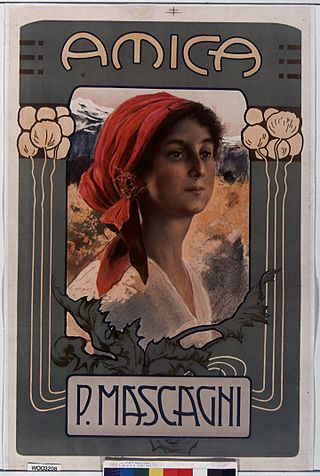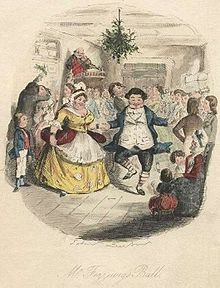
Amahl and the Night Visitors is an opera in one act by Gian Carlo Menotti with an original English libretto by the composer. It was commissioned by NBC and first performed by the NBC Opera Theatre on December 24, 1951, in New York City at NBC Studio 8H in Rockefeller Center, where it was broadcast live on television from that venue as the debut production of the Hallmark Hall of Fame. It was the first opera specifically composed for television in the United States.

Ivanhoé is an 1826 pastiche opera in three acts with music by Gioachino Rossini to a French-language libretto by Émile Deschamps and Gabriel-Gustave de Wailly, after Walter Scott's 1819 novel of the same name. The music was adapted, with the composer's permission, by the music-publisher Antonio Pacini from Rossini's operas, namely Semiramide, La Cenerentola, La gazza ladra, and Tancredi in order to introduce his music to Paris. An examination of the score shows that Pacini also used music from Bianca e Faliero, Armida, Maometto II, Aureliano in Palmira, Sigismondo, Torvaldo e Dorliska, Mosè in Egitto and an amount of newly composed music including fanfares and the gallop that was later to become famous from its inclusion in Guglielmo Tell. The work was premiered on 15 September 1826, at the Odéon Theatre.

Amica is an opera in two acts by Pietro Mascagni, originally composed to a libretto by Paul Bérel. The only opera by Mascagni with a French libretto, it was an immediate success with both the audience and the critics on its opening night at the Théâtre du Casino in Monte-Carlo on 16 March 1905. Mascagni himself conducted the performance. The opera had its Italian premiere on 13 May 1905 at the Teatro Costanzi in Rome.

Gli equivoci, is an Italian opera buffa by Stephen Storace to a libretto by Lorenzo Da Ponte, based on Shakespeare's The Comedy of Errors.
Giulietta e Romeo is a dramma per musica by composer Niccolò Antonio Zingarelli with an Italian libretto by Giuseppe Maria Foppa after the 1530 novella of the same name by Luigi Da Porto and Shakespeare's Romeo and Juliet. The opera premiered at the Teatro alla Scala in Milan on 30 January 1796.

Antigone is an opera in three acts by Arthur Honegger to a French libretto by Jean Cocteau based on the tragedy Antigone by Sophocles. Honegger composed the opera between 1924 and 1927. It premiered on 28 December 1927 at the Théâtre Royal de la Monnaie with sets designed by Pablo Picasso and costumes by Coco Chanel.

Medea is an opera in three acts composed by Giovanni Pacini to a libretto by Benedetto Castiglia. It premiered on 28 November 1843 at the Teatro Carolino in Palermo, conducted by the composer with Geltrude Bortolotti in the title role. The libretto is based on the plays Medea by Euripides and Médée by Pierre Corneille.

Issé is an operatic pastorale héroïque by the French composer André Cardinal Destouches. Initially it was in three acts. The definitive revised version consists of a prologue and five acts. The libretto was by Antoine Houdar de la Motte. Although Destouches was only 25 at the time of its premiere, it is considered his best score.

Didone abbandonata is an opera in three acts composed by Domenico Sarro to a libretto by Pietro Metastasio of the same name which was based on the story of Dido and Aeneas from the fourth book of Virgil's Aeneid. The opera premiered on 1 February 1724 at the Teatro San Bartolomeo in Naples.

Amelia al ballo is a one-act opera buffa by Gian Carlo Menotti, who set his own Italian libretto. Composed during 1936 when Menotti was in his mid-twenties, it was the composer's first mature opera and first critical success. The opera recounts a series of farcical events as a young Italian socialite overcomes obstacles to her attendance at the first ball of the season.

Conchita is an opera in four acts and six scenes by composer Riccardo Zandonai. The work uses an Italian language libretto by Maurizio Vaucaire and Carlo Zangarini which is based on Pierre Louÿs's 1898 novel La Femme et le pantin. The work premièred in Milan at the Teatro dal Verme on 14 October 1911 with soprano Tarquinia Tarquini, who later married Zandonai in 1917, in the title role. Her portrayal was lauded by critics and she went on to perform Conchita at the Royal Opera, London (1912), the Cort Theatre in San Francisco (1912), the Philharmonic Auditorium in Hollywood (1912), the Heilig Theatre in Portland (1912), the Metropolitan Opera House in Philadelphia (1912), the Chicago Grand Opera Company (1913), and the Teatro di San Carlo in Naples (1913). The opera was published by G. Ricordi & Co in 1912.

L'Étoile de Séville is a grand opera in four acts composed by Michael William Balfe to a libretto by Hippolyte Lucas based on Andrés de Claramonte's 1623 play La Estrella de Sevilla. It premiered at the Théâtre de l'Académie Royale de Musique in Paris on 17 December 1845 with Rosine Stoltz in the title role.
Adelaide di Guesclino is an opera in two acts composed by Simon Mayr. The Italian libretto by Gaetano Rossi is based on Voltaire's 1734 play Adélaïde du Guesclin. The opera premiered at La Fenice in Venice on 1 May 1799 with Caterina Angiolini in the title role.

La rosa bianca e la rosa rossa is an opera in two acts composed by Simon Mayr to an Italian libretto by Felice Romani. It premiered at the Teatro Sant'Agostino, Genoa, on 21 February 1813. Set in England against the backdrop of the Wars of the Roses, Romani's libretto is based on René-Charles Guilbert de Pixérécourt's La rose blanche et la rose rouge. Mayr's opera has also been performed under the title Il trionfo dell'amicizia.
Fedra is an opera in two acts composed by Simon Mayr to an Italian-language libretto by Luigi Romanelli based on Racine's play Phèdre.

Les cadeaux de Noël is an opera in one act composed by Xavier Leroux to a French-language libretto by Émile Fabre. Described as a conte héroïque, it was premiered by the Opéra-Comique at the Salle Favart Theatre in Paris on Christmas Day 1915. Its story of four children, whose parents had been killed by German soldiers but who nevertheless found hope in a seemingly bleak Christmas, had a particular resonance with French audiences in the midst of World War I. The opera was a great success in Paris, and subsequently performed in Italy, Monte Carlo and Latin America.
Il trionfo di Clelia, Wq. 31, is an opera composed by Christoph Willibald Gluck. It takes the form of a dramma per musica in three acts. The Italian-language libretto by Pietro Metastasio is based on several semi-legendary narratives concerning the founding of the Roman Republic. The opera premiered on 14 May 1763 at the Teatro Comunale di Bologna. Although rarely performed since then, it was revived in London in 2012 at the Royal Opera House's Linbury Studio.

I Mori di Valenza is an opera in four acts composed by Amilcare Ponchielli to a libretto by Antonio Ghislanzoni. Ponchielli began composing the work in 1874, but at the time of his death in 1886, only the piano score for the first three acts and part of the fourth had been completed. The opera was later revised by Ponchielli's son Annibale and the orchestration and fourth act were completed by Arturo Cadore. It premiered on 17 March 1914 at the Théâtre du Casino in Monaco and ran for three performances.
Nitocri is an opera in two acts composed by Saverio Mercadante to libretto by Apostolo Zeno adapted by Lodovico Piossasco Feys. The libretto is a fictionalised account of the Egyptian queen Nitocris. The opera premiered at the Teatro Regio in Turin on 26 December 1824.
Die Geisterinsel is a singspiel in 3 acts by Johann Friedrich Reichardt to a libretto by Friedrich Wilhelm Gotter based on The Tempest by William Shakespeare.


















